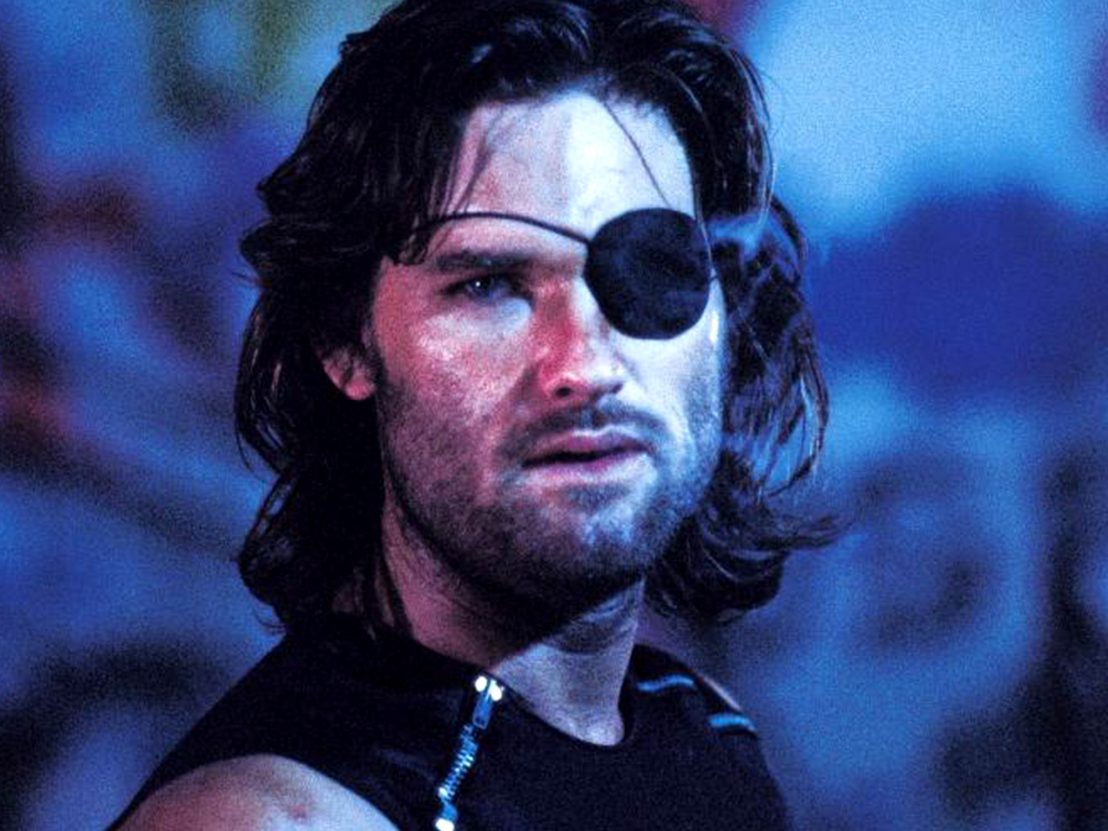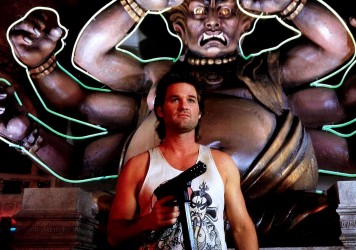
In the mid-1970s, when John Carpenter wrote Escape from New York in response to the Watergate scandal, 1997 was a distant – but not too distant – future onto which could be projected all manner of contemporary concerns. After the success of Halloween in 1978, Carpenter was able to secure a sufficient budget (a still modest $6 million) to realise his urban dystopia, and it was released in 1981, when 1997 was still not a real, tangible time so much as an imaginative pre-millennial arena for the projection of the (then) not quite now.
Also moving everything forwards is the driving, pulsing synth score – Carpenter’s own, in association with Alan Howarth – that plays over the stark white-on-black opening credits points. 1997 is the year in which the film’s events are set, but far from being a bright, progressive future, it is a hyperbolic deterioration of 1981’s here and now, in an America so riddled with crime and corruption that the whole of Manhattan Island has been converted into a “maximum security prison for the entire county”, its inmates, once exiled there, able to live by their own rules just so long as they never leave. No one escapes.
Right from the start we can tell that Snake Plissken (Kurt Russell) is an outlaw, whether from his insolent swagger, or from the pirate’s patch that he sports over his left eye, or from the metal cuffs binding his wrists and and the armed escort at his side. Snake is headed to Manhattan Island for robbing the Federal Reserve Depository, but in his fall from one-time decorated Special Forces war hero to common criminal, he also embodies a broader degeneration in the American values around him, as the free country for which he once fought has transformed into a fascist police state agains which he rebels.
On the eve of a potentially world-saving summit, Air Force One is hijacked and the President of the United States (Donald Pleasance) is sent crashing into the centre of the prison complex. Snake is half-recruited, half-tricked by Commissioner Bob Hauk (Lee Van Cleef) into an against-the-clock rescue mission, with a full pardon the reward for success, and death the punishment for failure.
From the moment we watch terrorists deliberately crash a plane into the New York skyline, a different kind of future, a little beyond 1997, is being envisaged here. For when, on 11 Sept, 2001, commentators kept repeating the mantra-like observation that the destruction of the Twin Towers was ‘just like a movie’, they probably had in mind something like Escape from New York, with its subjection of America’s financial hub and social melting pot to a defamiliarising disaster scenario.
Of course, the film itself was surfing a different kind of zeitgeist: for as Snake carries out his desperate one-day odyssey through urban gangs of freaks, marauders, cannibals and semi-civilised holdouts (including Ernest Borgnine’s Cabbie, Harry Dean Stanton’s Harold “Brain” Hellman and Adrienne Barbeau’s Maggie), Carpenter taps right into the sort of bleak futurism that also prevailed in Walter Hill’s The Warriors and George Miller’s Mad Max and Mad Max 2, where the future is a nightmare of depleted resources, regressive devolution and reigning chaos. Carpenter flags his other cinematic influences by naming one character Romero (Frank Doubleday) and another Cronenberg (John Strobel).
New York is now ruled over by The Duke (Isaac Shaft Hayes), a man whose savagery, callous disregard for the lives of others and pimpish flair for costumery have enabled him to rise to the very top of the litter (and to bring blaxploitation into the film’s already heady genre mix of SF action). Yet, for all the superficial differences (of race and class) between the Duke and the President, the similarities are just as striking, with POTUS utterly unconcerned by the considerable collateral damage wrought to return him to power.
The MacGuffin here is a cassette tape (a format that would barely outlast the ’80s) which the President is carrying in his briefcase, with a recorded speech on nuclear fission that might just help bring peace (and limitless energy) to a world at war. Yet would-be saviour Snake represents a different, older set of values, familiar from any western. “I don’t give a fuck about your war, or your President,” he declares near the start. For Snake, a rugged individualist par excellence, is out for himself and certainly does not believe in the corrupted system that has built up around him.
His final gesture in the film, as he turns his back on the cynical merry-go-round of global politics, represents this anarchic ethos writ large. Yet it also, upon reflection, involves a deep-seated sentimentality for the sort of values maintained by Cabbie, an ageing, rather innocent character (and a nostalgist himself) whose old showtunes the world might perhaps do better to keep singing.
Escape from New York is released by StudioCanal in a brand new 4K restoration on EST, DVD, BD and 4K UHD on 26 November.
Published 18 Nov 2018

By Ewen Hosie
Released 30 years ago, John Carpenter’s frantic San Francisco beat ’em up has lost none of its cult appeal.

By Thomas Hobbs
A personal essay on the director’s 1980 horror, which returns to cinemas this Halloween.

In Michael Myers, director John Carpenter created an enduring yet harmful horror archetype.